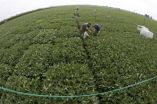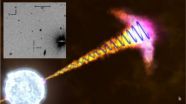(Press-News.org) CHAMPAIGN, Ill. — Researchers have some bad news for future farmers and eaters: As carbon dioxide levels rise this century, some grains and legumes will become significantly less nutritious than they are today.
The new findings are reported in the journal Nature. Eight institutions, from Australia, Israel, Japan and the United States, contributed to the analysis.
The researchers looked at multiple varieties of wheat, rice, field peas, soybeans, maize and sorghum grown in fields with atmospheric carbon dioxide levels like those expected in the middle of this century. (Atmospheric CO2 concentrations are currently approaching 400 parts per million, and are expected to rise to 550 ppm by 2050.)
The teams simulated high CO2 levels in open-air fields using a system called Free Air Concentration Enrichment (FACE), which pumps out, monitors and adjusts ground-level atmospheric CO2 to simulate future conditions. In this study, all other growing conditions (sunlight, soil, water, temperature) were the same for plants grown at high-CO2 and those used as controls.
The experiments revealed that the nutritional quality of a number of the world's most important crop plants dropped in response to elevated CO2.
The study contributed "more than tenfold more data regarding both the zinc and iron content of the edible portions of crops grown under FACE conditions" than available from previous studies, the team wrote.
"When we take all of the FACE experiments we've got around the world, we see that an awful lot of our key crops have lower concentrations of zinc and iron in them (at high CO2)," said University of Illinois plant biology and Institute for Genomic Biology professor Andrew Leakey, an author on the study. "And zinc and iron deficiency is a big global health problem already for at least 2 billion people."
Zinc and iron went down significantly in wheat, rice, field peas and soybeans. Wheat and rice also saw notable declines in protein content at higher CO2.
"Across a diverse set of environments in a number of countries, we see this decrease in quality," Leakey said.
Nutrients in sorghum and maize remained relatively stable at higher CO2 levels because these crops use a type of photosynthesis, called C4, which already concentrates carbon dioxide in their leaves, Leakey said.
"C4 is sort of a fuel-injected photosynthesis that maize and sorghum and millet have," he said. "Our previous work here at Illinois has shown that their photosynthesis rates are not stimulated by being at elevated CO2. They already have high CO2 inside their leaves."
More research is needed to determine how crops grown in developing regions of the world will respond to higher atmospheric CO2, Leakey said.
"It's important that we start to do these experiments in tropical climates with tropical soils, because that's just a terrible gap in our knowledge, given that that's where food security is already the biggest issue," he said.
INFORMATION:
The collaboration included researchers from Harvard University (which led the effort); Ben-Gurion University of the Negev, in Beer Sheva, Israel; the University of Illinois at Urbana-Champaign; the University of California, Davis; the U.S. Department of Agriculture's Agricultural Research Service; the National Institute for Agro-Environmental Sciences in Ibaraki, Japan; the University of Melbourne, Australia; the University of Arizona; the University of Pennsylvania; and The Nature Conservancy, Santa Fe, New Mexico.
Editor's notes: To reach Andrew Leakey, call 217-244-0302; email leakey@illinois.edu.
The paper, "Rising Concentration of Atmospheric CO2 Threatens Human Nutrition," is available online or to members of the news media from the U. of I. News Bureau.
As CO2 levels rise, some crop nutrients will fall
2014-05-07
ELSE PRESS RELEASES FROM THIS DATE:
Scientists create first living organism that transmits added letters in DNA 'alphabet'
2014-05-07
LA JOLLA, CA—May 7, 2014—Scientists at The Scripps Research Institute (TSRI) have engineered a bacterium whose genetic material includes an added pair of DNA "letters," or bases, not found in nature. The cells of this unique bacterium can replicate the unnatural DNA bases more or less normally, for as long as the molecular building blocks are supplied.
"Life on Earth in all its diversity is encoded by only two pairs of DNA bases, A-T and C-G, and what we've made is an organism that stably contains those two plus a third, unnatural pair of bases," said TSRI Associate Professor ...
Vascular simulation research reveals new mechanism that switches in disease
2014-05-07
BOSTON -- Blood vessel formation is critical to life and its manipulation is instrumental to a number of diseases. For more than 40 years, investigations into the structure and function of endothelial cells lining the blood vessels have revealed a complex tissue with complex functions, demonstrating that endothelial cells participate in all aspects of vascular homeostasis and pathological processes.
Today, important revelations regarding endothelial cell behavior are emerging from vascular simulation research, a blossoming interdisciplinary field that makes use of novel ...
Airborne measurements confirm leaks from oil and gas operations
2014-05-07
During two days of intensive airborne measurements, oil and gas operations in Colorado's Front Range leaked nearly three times as much methane, a greenhouse gas, as predicted based on inventory estimates, and seven times as much benzene, a regulated air toxic. Emissions of other chemicals that contribute to summertime ozone pollution were about twice as high as estimates, according to the new paper, accepted for publication in the American Geophysical Union's Journal of Geophysical Research: Atmospheres.
"These discrepancies are substantial," said lead author Gabrielle ...
Astronomers create first realistic virtual universe
2014-05-07
Move over, Matrix - astronomers have done you one better. They have created the first realistic virtual universe using a computer simulation called "Illustris." Illustris can recreate 13 billion years of cosmic evolution in a cube 350 million light-years on a side with unprecedented resolution.
"Until now, no single simulation was able to reproduce the universe on both large and small scales simultaneously," says lead author Mark Vogelsberger (MIT/Harvard-Smithsonian Center for Astrophysics), who conducted the work in collaboration with researchers at several institutions, ...
Brain noise found to nurture synapses
2014-05-07
NEW YORK, NY (May 7, 2014) — A study has shown that a long-overlooked form of neuron-to-neuron communication called miniature neurotransmission plays an essential role in the development of synapses, the regions where nerve impulses are transmitted and received. The findings, made in fruit flies, raise the possibility that abnormalities in miniature neurotransmission may contribute to neurodevelopmental diseases. The findings, by researchers at Columbia University Medical Center (CUMC), were published today in the online edition of the journal Neuron.
The primary way ...
Native algae species to blame for 'rock snot' blooms in rivers worldwide
2014-05-07
VIDEO:
The recent appearance of the freshwater algae known as "rock snot " on river bottoms worldwide is caused by a native species responding to changing environmental conditions rather than by accidental...
Click here for more information.
The recent blooms of the freshwater algae known as "rock snot" on river bottoms worldwide are caused by a native species responding to changing environmental conditions rather than by accidental introductions by fishermen or the ...
Early depression, anger may taint love life even 20 years later, study shows
2014-05-07
A University of Alberta study is helping crack the code to happiness by exploring the long reach of depression and anger over more than two decades.
The study, published recently in the Journal of Family Psychology, followed 341 people for 25 years, and found that negative emotions they may have suffered as young adults can have a lasting grip on their couple relationships, well into middle age.
The fact that depression and anger experienced during the teen years clung to people, even through major life events such as child-rearing, marriages and careers was surprising, ...
Community doulas can be a big help for mother-baby relationships
2014-05-07
Young mothers are more likely to breastfeed and have positive relationships with their babies when they have another woman "mothering" them in the delivery room, according to new research at the University of Chicago on the value of doulas—women who help with deliveries and early care for mothers and babies.
The assistance from doulas is particularly valuable to young mothers from disadvantaged backgrounds. Those mothers sometimes receive help from women known as community doulas, who are from similar backgrounds as the young women and who visit them weekly for several ...
Emerald ash borers were in US long before first detection
2014-05-07
EAST LANSING, Mich. — New research at Michigan State University shows that the uber-destructive emerald ash borer arrived at least 10 years before it was first identified in North America.
The study, published in the current issue of journal Diversity and Distributions, shows that EABs were feasting on ash trees in southeast Michigan by the early 1990s, well before this pest was discovered in 2002, said Deb McCullough, MSU professor of forest entomology.
"We suspect they arrived inside wood crating or pallets imported from Asia where the beetle is native," she said. ...
Clues about black hole formation
2014-05-07
This news release is available in Spanish.
The work, which has had the participation of the Ikerbasque researcher Javier Gorosabal, co-director of the Associated Unit with the Institute of Astrophysics of Andalusia/CSIC-UPV/EHU, has been published in the prestigious journal Nature.
There is no other event in the cosmos that can compete in terms of energy and intensity with stellar explosions on the outer reaches of the universe and which are known as LGRBs (Long Gamma-Ray Bursts): in just one second a single GRB can emit as many as hundreds of stars like the Sun ...






